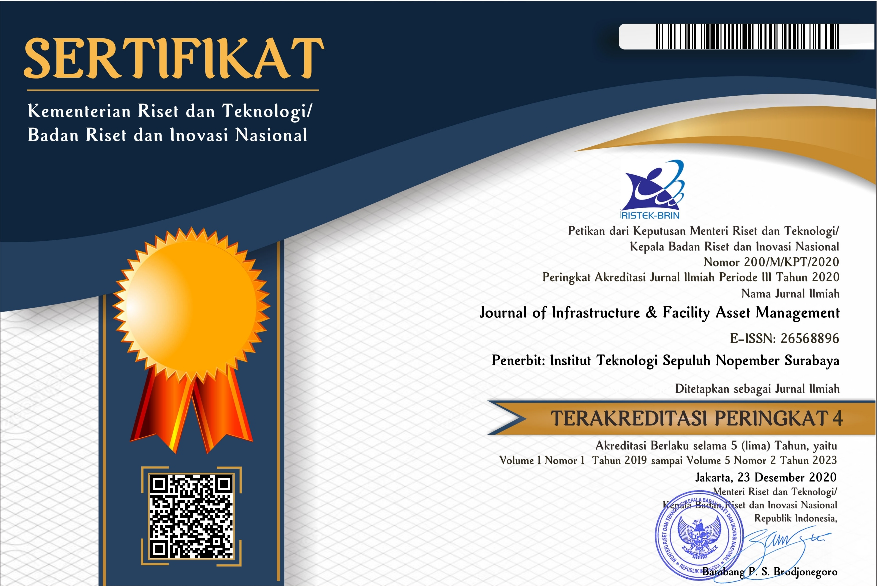Alternative of Soil Improvement Methods on Organic Soil Using Preloading and Vertical Piles for Embankment with Varied Heights. Case Study: Construction of Batanjung Port Access Road in Pulang Pisau Regency, Central Kalimantan
Abstract
The Central Kalimantan is a province with great potential for economic development. Several development plans have been launched by the government, one of which is the construction of the Batanjung Industrial Estate, Batanjung Port , and its access. The Batanjung Port development plan is in line with the Central Kalimantan Provincial Spatial Plan (RTRW) for 2015-2035, and has been stipulated in the National Medium-Term Development Plan (RPJMN) 2020-2024 and the Strategic Plan of the Ministry of General Works and Public Housing for 2020-2024. Therefore, it is necessary to build an access road to the Port of Batanjung, Central Kalimantan.
However, constructing new roads requires cautious construction plan considering the type of soil in Central Kalimantan Province which is dominated by soft soils and organic soils formed by weathered plants and has a high groundwater table. Problems that generally arise include the occurrence of long and large compression (settlement) and road embankment slides. Common efforts to increase the bearing capacity of organic soil in Central Kalimantan are the installation of galam wood driven piles into the soil and the use of geosynthetic such as geotextiles. Therefore, in this study a new road embankment using national road standards is planned by observing the 5-year and 50-year Flood Water Levels (FWL) in Central Kalimantan Province. The construction use mechanical soil improvement in the form of PVD, wood piles, micropile, and geotextiles for varying road embankment heights. Then the planning results are analyzed to find out the most efficient method in terms of material use.
Based on the analysis, the most efficient soil improvement method is the PVD method to accelerate consolidation rather than the micropile method to reduce the amount of compression. In addition, the most efficient reinforcement is by using geotextiles instead of galam wood piles. These results can be appled to both 5-year and 50-year FWL.
Full Text:
PDFReferences
ASTM Annual Book (1992). “Standard Classification of Peat Samples by Laboratory Testing (D4427-92)”. ASTM, Section 4, Volume 04.08 Soil and Rock. Philadelphia.
BSN SNI 8460: 2017. (2017). Persyaratan Perancangan Geoteknik. Badan Standardisasi Nasional. Jakarta.
Basyaruddin, dkk. (2019). Potensi Pemanfaatan Kayu Gelam dan Kayu Sengon dalam Dunia Konstruksi Berdasarkan Uji Kuat. Institut Teknologi Kalimantan. Balikpapan.
Desiani, Asriwijanti (2017). Kajian Pengaruh Materi Organik Pada Sifat Fisis Tanah Lunak. Universitas Katolik Parahyangan. Bandung.
Gibson, R.W., Lo, K.Y (1961). A Theory of Consolidation of Soils Exhibiting Secondary Compression. Acta Polytecnica Scandinavia. Scandinavia.
Perda Provinsi 5/15 (2015). Peraturan Daerah Provinsi Kalimantan Tengah Nomor 5 Tahun 2015 tentang Rencana Tata Ruang Wilayah Provinsi Kalimantan Tengah Tahun 2015 – 2035. Pemerintah Provinsi Kalimantan Tengah. Palangka Raya.
Kemen PUPR 05/18 (2018). Peraturan Menteri Pekerjaan Umum Dan Perumahan Rakyat Nomor 05/PRT/M/2018 tentang Penetapan Kelas Jalan Berdasarkan Fungsi dan Intensitas Lalu Lintas serta Daya Dukung Menerima Muatan Sumbu Terberat dan Dimensi Kendaraan Bermotor. Kementerian Pekerjaan Umum dan Perumahan Rakyat. Jakarta.
Kemen PUPR 19/11 (2011). Peraturan Menteri Pekerjaan Umum Nomor : 19/PRT/M/2011 tentang Persyaratan Teknis Jalan dan Kriteria Perencanaan Teknis Jalan. Kementerian Pekerjaan Umum dan Perumahan Rakyat. Jakarta.
Kemen PUPR 02/17 (2017). Manual Desain Perkerasan Jalan (Revisi 2017) Nomor 02/M/BM/2017. Kementerian Pekerjaan Umum dan Perumahan Rakyat. Jakarta.
Kemen PUPR (2020). Rencana Strategis Kementerian Pekerjaan Umum Dan Perumahan Rakyat Tahun 2020–2024. Jakarta.
Mochtar, N. E. & Mochtar, Indrasurya B. (1991). Studi Tentang Sifat Phisik dan Sifat Teknis Tanah Gambut Banjarmasin dan Palangkaraya Serta Alternatif Cara Penanganannya untuk Konstruksi Jalan. DIKTI. Jakarta.
Mochtar, NE. dan Imananto, E.I. (1999). “Aplikasi Model Gibson & Lo untuk Tanah Gambut Berserat di Indonesia”. Jurnal Teknik Sipil, ITB, Vol. 6 N0. 1. Bandung.
Departemen Permukiman & Prasarana Wilayah (2002). Panduan Geoteknik 1 (Proses Pembentukan dan Sifat-Sifat Dasar Tanah Lunak). Jakarta.
Pemerintah Republik Indonesia 34/06 (2006). Peraturan Pemerintah Nomor 34 Tahun 2006 tentang Jalan. Sekretariat Negara RI. Jakarta.
Pemerintah Republik Indonesia 18/20 (2020). Peraturan Presiden Republik Indonesia Nomor 18 Tahun 2020 tentang Rencana Pembangunan Jangka Menengah Nasional 2020-2024. Sekretariat Negara RI. Jakarta.
Terzaghi, K. (1925). “Principles of Soil Mechanics”. Engr. News Record, Vol. 95, pp. 832-836.
Waruwu, dkk. (2012). “Perilaku Pemampatan Tanah Gambut Berserat”. Jurnal Teknik Sipil Institut Teknologi Medan Volume 26 (No. 1): ISSN : 0854-4468. Medan.
Yulianto, F.E. and Mochtar, N.E. (2015). “Penggunaan Metode Gibson & Lo Untuk Prediksi Pemampatan Tanah Gambut Berserat Yang Mengalami Penurunan Muka Air”. Prosiding Seminar Teknik Sipil XI-2015. Surabaya.
DOI: http://dx.doi.org/10.12962%2Fjifam.v5i0.16225
Refbacks
- There are currently no refbacks.
Visitor :
Flag Counter

Journal Of Infrastructure & Facility Asset Management by Institut Teknologi Sepuluh Nopember is licensed under a Creative Commons Attribution-ShareAlike 4.0 International License.





